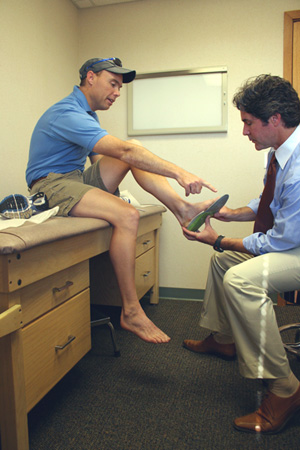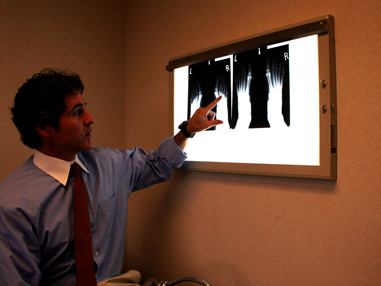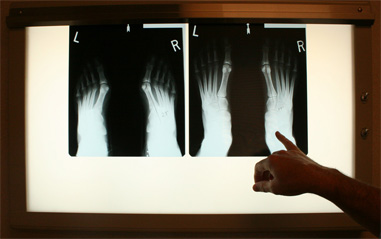Meet Dr. Feet
Published June 27, 2007
By STEPHEN REGENOLD
The pain in Mike Levad’s heel first pricked up after the Twin Cities Marathon last fall. “It felt like someone had whacked my heel with a hammer,” he said, describing a pain that shot through his foot and up the leg when he got out of bed in the morning.
In April, Levad ran the Boston Marathon.
“I finished in 3 hours, 5 minutes and 46 seconds,” said Levad, a 38-year-old museum-exhibit developer from Minneapolis. “But then the pain in my heel got worse.”
Levad is victim of an injury caused not by a one-time traumatic incident, but by the repetitive strain of feet pounding pavement. Indeed, during peak training times, runners such as Levad tick off 30, 40 or more miles in running shoes each week, striking foot to road tens of thousands of times. The abuse can affect the physiology of the foot, creating conditions unique to the running world that—as in Levad’s case—are difficult for some doctors to diagnose or treat.

That’s where Dr. Paul Langer comes in.
As an avid runner as well as a podiatrist, Langer combines medical knowledge with a personal athletic expertise. He practices with Minnesota Orthopaedic Specialists in Minneapolis and also serves as a clinical faculty member at the University of Minnesota Medical School. As a runner, Langer has been at it for more than 20 years, with two dozen marathons, several triathlons and the Ironman under his belt.
“Running is a passion,” said Langer, a 40-year-old who lives in Minneapolis with his wife, Michelle, and his training buddy, Ripley, a lab mix.
Patients such as Levad, who started seeing Langer last month, are sometimes dissatisfied with the diagnosis or treatment of non-running doctors.
“My first doctor prescribed something that didn’t end up helping very much,” Levad said. “I needed someone with a more precise knowledge of the stresses that running puts on the feet.”
For Langer, the journey from a non-runner to a local expert on the foot in motion began as a sophomore in college when he noticed his pants getting tight.
“I was putting on a couple pounds, and I decided to start running,” he said.
A job at a running store during medical school further piqued Langer’s interest toward the foot. He was fascinated by running and the human gait.










